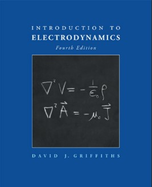Solution Found!
Calculate the electric and magnetic fields of an
Chapter 11, Problem 5P(choose chapter or problem)
Problem 5P
Calculate the electric and magnetic fields of an oscillating magnetic dipole without using approximation 3. [Do they look familiar? Compare Prob. 9.35.] Find the Poynting vector, and show that the intensity of the radiation is exactly the same as we got using approximation 3.
Reference prob.9.35
Suppose
(This is, incidentally, the simplest possible spherical wave. For notational convenience, let (kr − ωt) ≡ u in your calculations.)
(a) Show that E obeys all four of Maxwell’s equations, in vacuum, and find the associated magnetic field.
(b) Calculate the Poynting vector. Average S over a full cycle to get the intensity vector I. (Does it point in the expected direction? Does it fall off like r−2, as it should?)
(c) Integrate I · da over a spherical surface to determine the total power radiated.
Questions & Answers
QUESTION:
Problem 5P
Calculate the electric and magnetic fields of an oscillating magnetic dipole without using approximation 3. [Do they look familiar? Compare Prob. 9.35.] Find the Poynting vector, and show that the intensity of the radiation is exactly the same as we got using approximation 3.
Reference prob.9.35
Suppose
(This is, incidentally, the simplest possible spherical wave. For notational convenience, let (kr − ωt) ≡ u in your calculations.)
(a) Show that E obeys all four of Maxwell’s equations, in vacuum, and find the associated magnetic field.
(b) Calculate the Poynting vector. Average S over a full cycle to get the intensity vector I. (Does it point in the expected direction? Does it fall off like r−2, as it should?)
(c) Integrate I · da over a spherical surface to determine the total power radiated.
ANSWER:
Solution 5P
Step 1 of 3:
We need to find out the electric and magnetic fields of an oscillating magnetic dipole without using the approximation and also find the Poynting vector, and show that the intensity of the radiation is exactly the same as we got using approximation .
